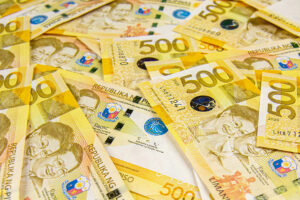




Philippines Trade Update: Trade trajectories trend along
 DOWNLOAD
DOWNLOAD

Policy Rate Updates: Double cut finale
 DOWNLOAD
DOWNLOAD

Monthly Economic Update: One for the road
 DOWNLOAD
DOWNLOAD


Peso may move sideways vs dollar ahead of inflation data

THE PESO could trade sideways against the dollar this week as the market awaits the release of March inflation data and ahead a trading break in observance of Holy Week.
The local currency closed at PHP 54.36 versus the greenback on Friday, climbing by 5.5 centavos from Thursday’s PHP 54.415 finish, Bankers Association of the Philippines data showed.
Week on week, the peso inched down by a centavo from its PHP 54.35 finish on March 24.
The peso opened Friday’s session stronger at PHP 54.35 per dollar. Its worst showing was at PHP 54.385, while its intraday best was at PHP 54.28 versus the greenback.
Dollars traded declined to USD 942.6 million on Friday from the USD 1.01 billion recorded on Thursday.
The peso rose against the dollar on Friday, supported by remittance inflows in anticipation of an extended Holy Week break, Rizal Commercial Banking Corp. Chief Economist Michael L. Ricafort said in a Viber message.
Hawkish statements from BSP Governor Felipe M. Medalla also boosted the peso, Mr. Ricafort added.
It may be too soon for the Philippine central bank to pause from raising interest rates at its next policy meeting in May, Bangko Sentral ng Pilipinas (BSP) Governor Felipe M. Medalla said, signaling its most aggressive tightening cycle in two decades could continue, Bloomberg reported.
May is “too early” to pause, “unless we actually see a price fall,” Mr. Medalla said in an interview Thursday on the sidelines of the Association of Southeast Asian Nations forum in Bali, Indonesia. The Bangko Sentral ng Pilipinas expects headline inflation this month to cool to a range of 7.4%-8.2% when the statistics agency reports the data on April 5, it said in a monthly forecast on Friday.
The BSP remains “cautious” and needs to see “enough low month-on-month inflation, to give the public confidence that the BSP forecast of inflation averaging 2.9% is quite likely,” Mr. Medalla said in the interview, referring to its 2024 estimate.
Annual inflation stood at 8.6% in February, still near a 14-year high, and the core gauge, which strips out volatile food and fuel costs, was the fastest in 24 years. Mr. Medalla said the central bank could pause its rate hike cycle if prices decline on a month-on-month basis. The price index in February was unchanged from January.
It’s the latest signal from the BSP chief that the tightening cycle can extend even after it has raised its key rate by 425 basis points since May, among the most aggressive moves in the region. On Wednesday, Mr. Medalla said the BSP can raise policy rate further without risking financial stability.
For this week, Union Bank of the Philippines, Inc. Chief Economist Ruben Carlo O. Asuncion said in a report that the peso could move sideways as the Holy Week break could increase remittances.
“The extended Lenten week break (no work from Maundy Thursday to Easter Monday) means more dollar selling during the three-day work week to make room for remittances and other inflows expected to bunch up during the long break with limited corporate FX (foreign currency) demand as we start the new month,” Mr. Asuncion said.
He said the peso could strengthen if inflation slowed in March, as this could mean a pause by the central bank in its next meeting on May 18.
“Additional support for buying peso on rallies is the BSP aiming for a peak policy rate of 6.5% in May followed by a pause-and-hold,” he said.
A BusinessWorld poll of 16 analysts yielded a median estimate of 8.1% for March headline inflation, near the higher end of the BSP’s 7.4% to 8.2% forecast for the month.
If realized, this would ease from the 8.6% in February but rise from the 4% print in March 2022.
March would also be the 13th straight month that inflation exceeded the BSP’s 2-4% target for the year.
Mr. Asuncion expects the peso to trade between PHP 54.20 and PHP 54.60 this week, while Mr. Ricafort sees it moving from PHP 54.10 to PHP 54.50 per dollar. — AMCS
This article originally appeared on bworldonline.com





 By BusinessWorld
By BusinessWorld